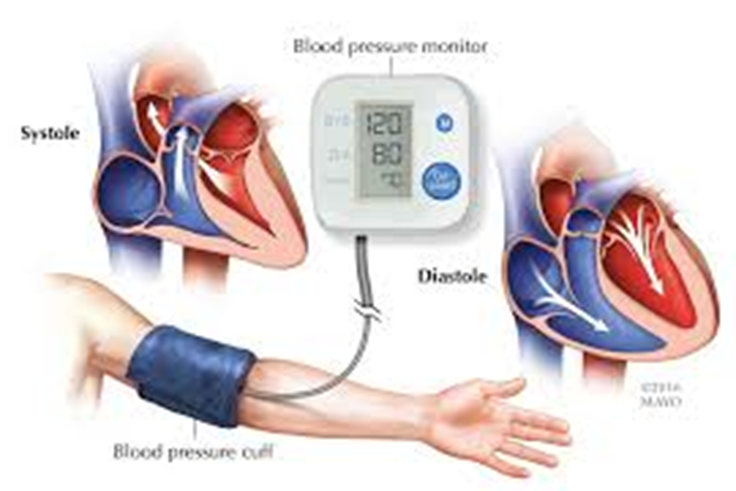A client has arrived at the clinic for a routine physical examination. Prior to assessing the client's blood pressure, what should the nurse do?

Position the arm so that it is below waist level.
Palpate the radial artery to confirm a pulse is present.
Ask the client to sit quietly in a chair for 5 minutes.
Make sure the arm selected is covered with clothing.
The Correct Answer is C
Choice A Reason:
Positioning the arm below waist level is not recommended when measuring blood pressure. It can result in an inaccurate reading, typically showing a higher blood pressure due to the effects of gravity on the blood column. The arm should be positioned at heart level for an accurate measurement.
Choice B Reason:
While palpating the radial artery to confirm a pulse is present is part of the overall assessment of circulation, it is not a necessary step immediately before measuring blood pressure. The focus should be on ensuring the client is in the correct position and is relaxed to avoid any factors that might artificially alter the blood pressure reading.
Choice C Reason:
Asking the client to sit quietly in a chair for 5 minutes is the correct procedure before measuring blood pressure. This allows the client's heart rate and blood pressure to stabilize, providing a more accurate measurement. Any activity or stress can temporarily raise blood pressure, so this quiet time is crucial.
Choice D Reason:
The arm selected for blood pressure measurement should not be covered with clothing. Clothing can constrict the blood pressure cuff and interfere with the accuracy of the reading. The cuff should be placed on bare skin to ensure it inflates and deflates correctly and that the stethoscope can accurately detect the sounds of the blood flow.
Nursing Test Bank
Naxlex Comprehensive Predictor Exams
Related Questions
Correct Answer is C
Explanation
Choice A reason:
Acute pain is typically sudden in onset and is usually the result of a specific injury or illness. It is characterized by its sharp quality and tends to last for a short duration, generally not longer than six months. Since the patient's knee pain has persisted for eleven months, it does not fall under the category of acute pain.
Choice B reason:
Intermittent pain is pain that comes and goes at intervals. Although the patient's pain could be intermittent, the classification based on duration would not be described as intermittent. This term refers more to the pattern of the pain rather than its chronicity or cause.
Choice C reason:
Chronic pain is defined as pain that persists for longer than six months, often continuing even after the injury or illness that caused it has healed. The patient's bilateral knee pain has been present for eleven months, which exceeds the six-month threshold, thus categorizing it as chronic pain.
Choice D reason:
Idiopathic pain refers to pain that arises without a clear cause. It is not categorized based on the duration of the pain but rather on the absence of an identifiable underlying reason. Since the patient's pain has a specific duration, it is not appropriate to classify it as idiopathic without further information regarding its cause.
Correct Answer is C
Explanation
Choice a reason:
The inability of the eye to look outward, known as lateral rectus palsy, is associated with cranial nerve VI, the abducens nerve, not the oculomotor nerve. The oculomotor nerve does not control the lateral rectus muscle which governs this movement.
Choice b reason:
Myopia, or nearsightedness, is a refractive error of the eye where distant objects appear blurry while close objects can be seen clearly. It is not related to oculomotor nerve paralysis, which affects eye movements and pupil response, not the shape of the eyeball or the refractive properties of the lens.
Choice c reason:
Ptosis, or drooping of the upper eyelid, and an absence of pupillary constriction are classic signs of oculomotor nerve paralysis. The oculomotor nerve controls most of the eye's movements, including lifting the eyelid via the levator palpebrae superioris muscle and constricting the pupil through the circular muscles of the iris.
Choice d reason:
Normal eye movement would not be expected in a patient with oculomotor nerve paralysis. This nerve controls the majority of the eye's movements, so paralysis would lead to abnormal eye movement, such as the inability to move the eye upward, downward, or inward.
Whether you are a student looking to ace your exams or a practicing nurse seeking to enhance your expertise , our nursing education contents will empower you with the confidence and competence to make a difference in the lives of patients and become a respected leader in the healthcare field.
Visit Naxlex, invest in your future and unlock endless possibilities with our unparalleled nursing education contents today
Report Wrong Answer on the Current Question
Do you disagree with the answer? If yes, what is your expected answer? Explain.
Kindly be descriptive with the issue you are facing.
